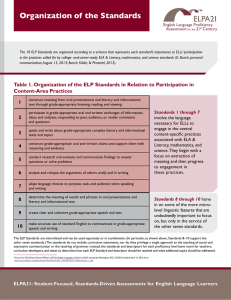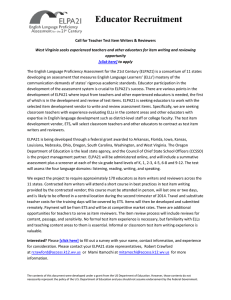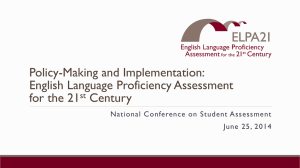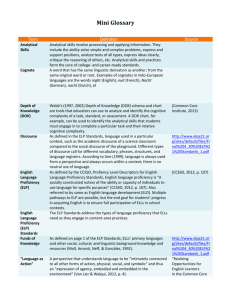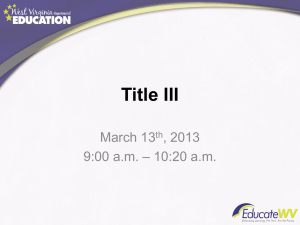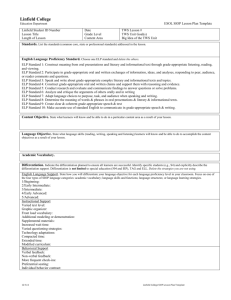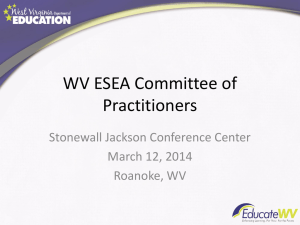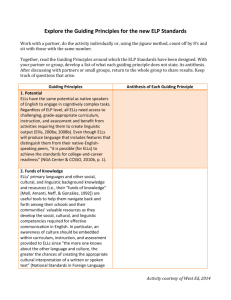West Virginia Overview: English Language Proficiency Assessment for the 21 Century
advertisement
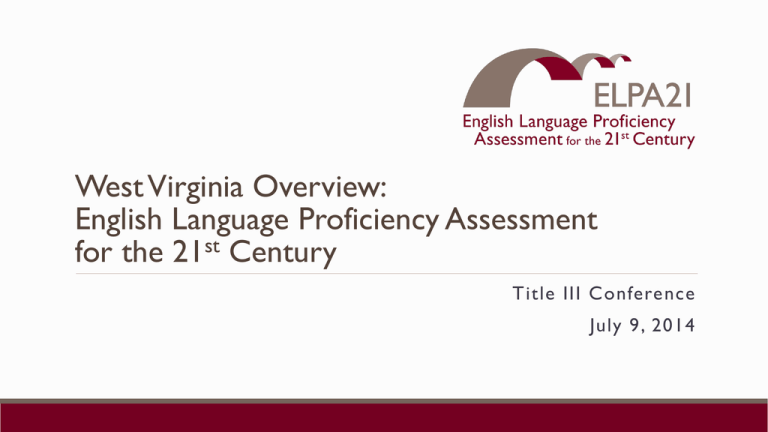
West Virginia Overview: English Language Proficiency Assessment for the 21st Century Title III Conference July 9, 2014 English Language Proficiency Reexamined - E L PA 2 1 O v e r v i e w - Evolution of Standards & Assessments for ELLs - State and Federal Policy: Implications for Implementation & PD Framework - Item Development - F i e l d Te s t i n g - E L PA 2 1 We b s i t e ELPA21 Overview Project Overview Awarded $6.3 million four-year Enhanced Assessment Grant, September 2012 11 participating states Fiscal Agent: Oregon Department of Education Project Management Partner: Council of Chief State School Officers (CCSSO) Collaborative Partners: •Understanding Language Initiative (Stanford University) •National Center for Research on Evaluation, Standards, and Student Testing (CRESST) of the University of California, Los Angeles •National Center on Educational Outcomes (NCEO) of the University of Minnesota ELPA21 Consortium States ELPA21 Mission Acknowledging the diverse and rich language experiences English language learners (ELLs) bring to school, we recognize their English language proficiency is constantly growing. ELPA21 measures that growth based on the new English Language Proficiency Standards and provides valuable information that informs instruction and facilitates academic English proficiency so that all ELLs leave high school prepared for college and career success. ELPA21 Vision To provide assessments that best measure English language learners’ mastery of the communication demands of states’ rigorous academic standards. Assessment System Features •Comprehensive online delivery •Innovative Technology Enhanced Items •Cohesive system to integrate with existing district policies and enhance the student’s experience through strong engagement, and minimal testing time •High-quality communications for the states’ adaptation for constituents and high quality resources for professional development •Sustainability to respond to states’ need for valid and reliable assessment, maximize information, and minimize cost System Timeline • Item bank development (ongoing) • Contrasting Groups Study, Jan. 2015 • User Acceptability Testing, Jan. 2015 • Field Test, Feb./Mar. 2015 • Operational Summative Test, SY 2015-2016 • Screener, SY 2016-2017 Evolution of Standards & Assessments for ELLs The Cyclops Problem New Paradigm Content Discourse Text (complex text) Explanation Argumentation Purpose Typical structure of text Sentence structures Vocabulary practices Language ELP Standards: When ELLs use language effectively as they progress toward independent participation in grade-appropriate activities to attain college and career readiness, they can…. 1 construct meaning from oral presentations and literary and informational text through grade-appropriate listening, reading, and viewing 2 participate in grade-appropriate oral and written exchanges of information, ideas, and analyses, responding to peer, audience, or reader comments and questions 3 speak and write about grade-appropriate complex literary and informational texts and topics 4 construct grade-appropriate oral and written claims and support them with reasoning and evidence 5 conduct research and evaluate and communicate findings to answer questions or solve problems 6 analyze and critique the arguments of others orally and in writing 7 adapt language choices to purpose, task, and audience when speaking and writing 8 determine the meaning of words and phrases in oral presentations and literary and informational text 9 create clear and coherent grade-appropriate speech and text 10 make accurate use of standard English to communicate in grade-appropriate speech and writing Fundamental Shift in How Language is Viewed:The New ELP Standards Our overarching focus addresses the following question: • What does it look like when English language learners (ELLs) use language effectively as they progress toward independent participation in gradeappropriate activities? See Understanding Language video of Aída Walqui: Language and the Common Core State Standards “language as action” http://www.youtube.com/watch?v=T3YJx8ujoto Benefits of New ELP Standards •Correspondence with more rigorous college- and career-ready standards (CCSS, NGSS) •Common ELP standards tied to common ELP assessment •Common expectations for ELLs across states •Shared expertise across states •Contributions from National ELL and Standards Development Experts State and Federal Policy: Implications for Implementation Policy Implications for using new generation ELP assessments Increasing guidance, support, and resources for educators to teach to the new standards State policies differ in the criteria used to to screen and determine growth and proficiency Recognize the impact on current and former ELLs who have been instructed and demonstrated growth based on previous ELP standards The impact of college and career ready ELP standards on AMAOs Ongoing growth and sustainability of consortia ELPA21 Governance Overview •Consortium Council • Membership: One representative from each member state appointed by the state’s education chief • Duties: Determines the broad picture and general scope of the ELPA21 system, makes policy recommendations, initial contact for expenditure of funds. •Executive Board • Membership: One representative from Oregon, plus five at-large representatives from member states elected by the Consortium Council • Duties: Final voice and decision-making entity on all issues and recommendations from the Consortium Council, coordinates policy formulation, and signs off on all major deliverables. •Task Management Teams ELPA21 Decision-Making PD Framework Development Framework Components • Layered Approach • Three-Year Cycle • Process/Protocols/Tools Layered Approach - Audience Based •Intro-Getting to Know the Standards •Grade Level/Band Modules (each integrating CC Practices/application) •Two Standards Per Month with one Intro and one Closing Module (7 training modules ideally delivered in 46 week increments to maintain learning momentum) •Closing-De-Briefing the Learning, Big Ahas Process/Protocols/Tools • Process • I do, We do,You do (scaffolded approach through implementation) • Blended Delivery Format (Synchronous and Asynchronous) • Protocols • Developed around 5 Areas (Leadership, Professional Development Content, Professional Learning Communities, Instructional Coaching, Implementation Studies) • Tools • Video-Taped Peer Review Lessons • Protocols • Rubrics/Metrics Three Year Cycle •3 Levels of Training •Year 1/Level 1- Introductory •Year 2/Level 2- Deeper Dive and Building Towards Exemplary •Year 3/Level 3- Certification and Master/Model Teacher (certificate, credit, video capture of master/model teachers, mentoring capacity, etc..) Questions? Item Development •ETS •Item Writer Training: May 28 -19, 2014 •Content and Bias Review: August 18 -22, 2014 •Virginia Guynn, BCS Field Test Update •Field Test Timeline -Field testing webinar (training) January 2015 -February 2015 – March 2015 •Field Test Vendor -Released RFP for the ELPA 21 Field Test Development and administration – 3/21/2014 -Three proposals were submitted and evaluated by 6 reviewers -Questar was selected as the Field Test Vendor -Budget for the Field Test - $1,800,183 Visit ELPA21.org for more information The contents of this presentation were developed under a grant from the U.S. Department of Education. However, those contents do not necessarily represent the policy of the U.S. Department of Education and you should not assume endorsement by the Federal government. ELPA 21 Website •http://www.elpa21.org/ •If the parents ask you what is the ELPA21 going to measure, where do you direct? •If the teachers ask you what are the ELPA21 reports going to show teachers, where do you direct? •If the educators ask you what kind of assessments will ELPA 21 produce, where do you direct? •Where can you find ELP Standards? What does this standard corresponds to?
